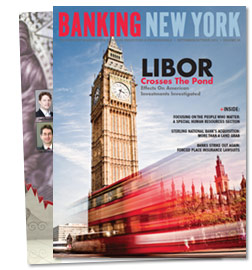 By Steve Viuker
By Steve Viuker
Attorneys general in at least five states are conducting investigations tied to alleged manipulation of the London interbank offered rate (LIBOR), adding to probes by U.S. and U.K. authorities.
The probes by New York, Connecticut, Massachusetts, Florida and Maryland are in different stages, according to the states. New York Attorney General Eric Schneiderman and George Jepsen in Connecticut are working together, and Massachusetts is talking with other states about possible coordination.
According to Bloomberg News, “The New York and Connecticut attorneys general have been looking into these issues for over six months, and will continue to follow the facts wherever they lead,” said James Freedland, a spokesman for Schneiderman. The scandal led to the resignation of Barclays PLC CEO Robert Diamond. Massachusetts is looking into the effect on state investments and is working with state agencies and municipalities, Florida Attorney General Pam Bondi’s office is “reviewing the matter,” and Maryland Attorney General Douglas Gansler is “looking into” the allegations.
Berkshire Bank, a New York lender with 11 branches, sued 21 banks, including Bank of America Corp., Barclays Plc and Citigroup Inc., for damages over the alleged manipulation. Berkshire sought undisclosed compensation and punitive damages and the right to represent other lenders in a group lawsuit, or class action, in a July 25 filing in federal court in Manhattan. The lender claims in the suit that LIBOR fraud lowered interest payments it received. Berkshire seeks to represent all banks, savings-and-loan institutions and credit unions that are based in New York or have most of their operations in the state. There are several hundred such institutions.
The Justice Department investigation of criminal activity related to LIBOR is moving on a parallel course with civil probes of the banks being conducted by the U.S. Commodity Futures Trading Commission, the Securities and Exchange Commission and U.K. regulators, including the Serious Fraud Office. The European Union promised stricter supervision of interbank lending rates and said on July 25 that it may expand antitrust probes of the manipulation. The penalties are tied to LIBOR and other indexes that have fallen to near historic lows since the financial crisis that began in 2007, forcing at least $4 billion of payments to end the agreements, according to data compiled by Bloomberg.
The California Public Employees Retirement System, the largest U.S public pension with $233 billion of assets, is examining the impact of LIBOR fixing on its portfolio and will make a judgment about whether to seek damages. Until now, most of the attention has involved traders at Barclays, which last month reached a $453 million settlement with U.S. and UK authorities for its role in the manipulation of rates. But traders from at least two other banks – UK-based Royal Bank of Scotland Group Plc and Switzerland’s UBS AG – played a central role.
The dollar and euro rate-rigging appears to have begun in earnest in early 2005 in the dollar market, according to the documents reviewed by Reuters. Soon, the trading had crossed to euro rate markets, according to the settlement documents filed in the Barclays investigation. And by 2007, traders at RBS and UBS were seeking to influence the yen rate market, according to documents filed in 2011 in Singapore’s High Court and in Canada’s Ontario Superior Court.
In August, The Wall Street Journal reported that several large mutual-fund companies, including Black Rock Inc. and Vanguard Group Inc., have launched internal investigations into whether their funds have been harmed by alleged interest-rate rigging by large banks. Mutual funds invest in a variety of securities and other financial instruments with interest rates tied to LIBOR. If some banks conspired to keep interest rates low, the returns received by the funds and their investors could have been affected. U.S. money-market funds, which have $2.5 trillion in assets, could be among the most affected because they invest in short-term debt that could be tied to LIBOR. Fixed-income securities are tied to Libor; so bond funds could be affected, as could hedge funds.
Les Jacobowitz is a partner in the New York office of Arent Fox and handles public finance issues. “This will be one of the largest financial crisis-related issues of the Great Recession confronting large banks due to the dollar magnitude of the issue and LIBOR’s broad use to consumers and companies,” he said. “It is estimated that there are $150 to $300 trillion of dollars of debt tied to LIBOR. These include variable rate mortgages, variable rate notes/bonds, commercial lines of credit and commercial loans. The magnitude of the settlement by Barclays illustrates that this scandal will dramatically affect other implicated banks due to the impact such settlements have on fostering costly litigation against such banks.”
Said Josh Passman, senior vice president of New York-based public relations firm Prosek Partners, “Any time we are faced with a scandal that causes the public to question the very underpinnings of our global financial system, it serves to increase the rampant mistrust that currently exists. With the LIBOR scandal, those that will ultimately pay the price for this alleged malfeasance are individual investors and depositors, businesses large and small and others that have zero control over how the rate is set, but are subject to its every move.”
Even Britian’s Poet Laureate Carol Ann Duffy ripped the banks. Duffy’s poem, “Translating the British, 2012,” appeared on the front page of The Guardian newspaper, next to a photograph of Somali-born British 10,000 metre champion Mo Farah. She referred to the banking scandals that have rocked London in recent years. “We’ve had our pockets picked,/the soft, white hands of bankers,/bold as brass, filching our gold, our silver;/we want it back.”
